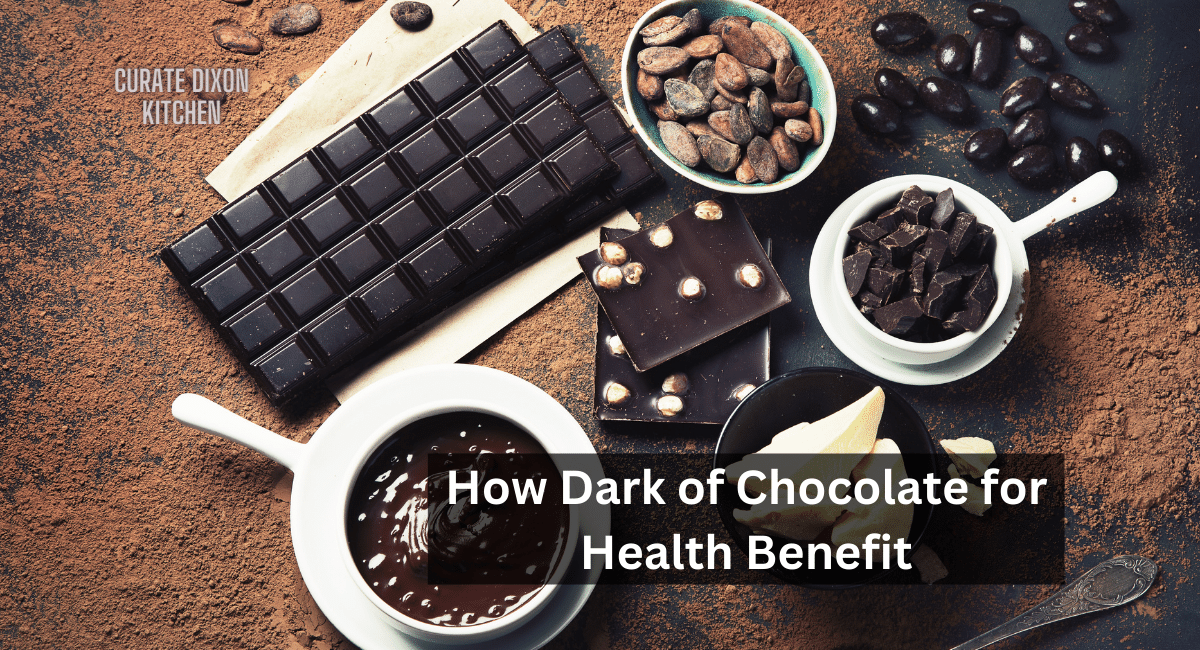Chocolate, often considered a decadent treat, has long been associated with pleasure and indulgence. However, not all chocolate is created equal. Dark chocolate, with its rich, bittersweet flavor, has gained popularity for its taste and potential health benefits. In this article, we will delve into dark chocolate and its varying cocoa percentages to understand how much it can contribute to improved health. Specifically, we will investigate the optimal cocoa percentage for maximizing health benefits, taking into account its impact on cardiovascular health, antioxidant properties, mood enhancement, and potential side effects.
1. Chocolate and Its Origins
Before diving into the health benefits of dark chocolate, it is essential to understand its origins and how it differs from other forms of chocolate. Chocolate is derived from cacao beans, the seeds of the cacao tree (Theobroma cacao). The process of making chocolate involves several steps, including harvesting, fermenting, drying, roasting, and grinding the cacao beans. The result is a paste known as chocolate liquor, which can be further processed to produce different types of chocolate, including dark chocolate.
The key factor distinguishing various chocolate types is the proportion of cacao solids and cacao butter (fat) they contain. Dark chocolate contains more cacao solids and less sugar than milk chocolate and white chocolate. This difference in composition gives dark chocolate its distinct flavor and potential health benefits.
2. Cocoa Percentage: The Spectrum of Dark Chocolate
Dark chocolate is available in a range of cocoa percentages, which represent the proportion of cacao solids in the chocolate. Cocoa percentages typically vary from about 50% to 100%. The higher the cocoa percentage, the more cacao solids and the less sugar the chocolate contains. The cocoa percentage is a critical factor in determining the health benefits and flavor of dark chocolate.
Cocoa Percentage and Flavor:
The cocoa percentage significantly influences the flavor profile of dark chocolate. Dark chocolate with a lower cocoa percentage tends to be sweeter and milder, with a more pronounced sugar content. As the cocoa percentage increases, the chocolate becomes progressively darker and more intense, with a richer and more bittersweet taste.
The flavor of dark chocolate is a result of the complex interplay between cacao solids, cacao butter, and sugar. Higher cocoa percentages mean a higher concentration of cacao solids, which contributes to the chocolate’s bitterness and intensity. However, this increase in cacao solids also allows for a more nuanced flavor profile as the subtleties of the cacao bean’s natural flavors become more pronounced.
Health Benefits and Cocoa Percentage:
The potential health advantages of dark chocolate are strongly associated with the amount of cocoa it contains. Cacao solids are packed with bioactive compounds like flavonoids, theobromine, and a range of antioxidants, all believed to have positive health effects. As the cocoa percentage increases, so does the concentration of these beneficial compounds. To grasp the health benefits of dark chocolate, it’s essential to investigate how the cocoa percentage affects various aspects of well-being:
3. Cardiovascular Health
One of the most well-documented health benefits associated with dark chocolate consumption is its potential to promote cardiovascular health. Moderate consumption of dark chocolate may have a positive impact on heart health. The key cardiovascular benefits associated with dark chocolate include:
Blood Pressure Regulation:
Dark chocolate has been proven to have a moderate yet notable impact on blood pressure. This influence is ascribed to the existence of flavonoids, especially flavanols, renowned for their capacity to relax blood vessels and enhance blood circulation. Typically, higher cocoa percentages in dark chocolate equate to a greater amount of flavanols, which could augment its potential to lower blood pressure.
Improved Cholesterol Profile:
Consuming dark chocolate with higher cocoa percentages has been linked to improvements in the lipid profile. The flavonoids in dark chocolate may help reduce low-density lipoprotein (LDL) cholesterol levels while increasing high-density lipoprotein (HDL) cholesterol levels. These changes in cholesterol levels are associated with a lower risk of cardiovascular disease.
Reduced Risk of Heart Disease:
Epidemiological studies suggest that consuming dark chocolate may be linked to a reduced risk of heart disease. Dark chocolates containing a higher cocoa content may contribute to a significant reduction in risk factors associated with cardiovascular problems, such as high blood pressure and elevated blood lipid levels.
4. Antioxidant Properties
Dark chocolate serves as a plentiful source of antioxidants, which play a vital role in shielding the body from oxidative stress and the harm caused by free radicals. The cocoa percentage has a direct impact on the antioxidant levels in dark chocolate, and this, consequently, affects its potential health advantages:
High Antioxidant Content:
Cacao beans are rich in antioxidants, which include flavonoids, polyphenols, and catechins. Research has demonstrated that these substances can effectively counteract detrimental free radicals and diminish oxidative harm to cells. Dark chocolate containing a greater proportion of cocoa contains a higher concentration of these antioxidants, making it a more robust provider of compounds that combat free radicals.
Anti-Inflammatory Effects:
The anti-inflammatory properties of dark chocolate are linked to its abundant antioxidant content. By reducing inflammation, dark chocolate may decrease the risk of chronic diseases like heart disease and neurodegenerative conditions. Dark chocolate with a higher cocoa content enhances its capability to counter inflammation.
Protection Against Aging:
The antioxidants in dark chocolate may protect the skin from UV damage, potentially reducing the signs of aging. Consuming dark chocolate with a higher cocoa percentage may provide greater skin benefits due to its increased antioxidant concentration.
5. Mood Enhancement
Dark chocolate is often associated with mood enhancement and a sense of well-being. This positive effect on mood is primarily attributed to the presence of theobromine, a natural stimulant found in cacao. The cocoa percentage influences the theobromine content, which in turn affects its mood-altering properties:
Theobromine and Mood:
Theobromine shares a structural resemblance with caffeine, though its stimulating impact is gentler. It has the potential to elevate mood by boosting the release of specific neurotransmitters, including serotonin and dopamine, which are linked to sensations of joy and contentment. Dark chocolate with a greater cocoa concentration contains a greater amount of theobromine and may produce a more significant mood-enhancing influence.
Stress Reduction:
Consuming a higher cocoa percentage of dark chocolate may help reduce stress and anxiety. The theobromine content and the pleasurable sensory experience of eating dark chocolate can contribute to a sense of relaxation and comfort.
6. Potential Side Effects and Moderation
Although dark chocolate has many potential health advantages, it’s crucial to enjoy it in moderation. Just like with any food, excessive consumption can result in adverse effects. Some possible side effects of overindulging in dark chocolate are:
Weight Gain:
Though lower in sugar than milk chocolate, dark chocolate is still calorie-dense. Overconsumption can contribute to weight gain if not balanced with an appropriate diet and physical activity.
Caffeine and Theobromine Sensitivity:
Individuals sensitive to caffeine or theobromine may experience jitteriness, insomnia, or increased heart rate when consuming dark chocolate with higher cocoa percentages.
Dental Health:
Dark chocolate contains sugar, which, if consumed excessively without maintaining proper oral hygiene, can contribute to dental cavities. To optimize the health advantages of dark chocolate while minimizing potential side effects, it is recommended to:
- Choose dark chocolate with a cocoa percentage that suits your taste preferences while providing the desired health benefits.
- Consume dark chocolate in moderation as part of a balanced diet.
- Be mindful of the total calorie intake, especially if weight management is a concern.
- Be aware of individual sensitivities to caffeine and theobromine.
7. Finding Your Ideal Dark Chocolate
Dark chocolate is a delicious treat with the potential to offer several health benefits when consumed in moderation. The cocoa percentage plays a crucial role in determining the extent of these benefits, as it affects flavor, antioxidant content, cardiovascular health, mood enhancement, and potential side effects.
For those seeking to optimize their health benefits from dark chocolate, here are some key takeaways:
- Choose dark chocolate with a cocoa percentage that suits your taste preferences and health goals. Higher cocoa percentages (70% and above) generally offer more health benefits.
- Enjoy dark chocolate in moderation as part of a balanced diet.
- Be mindful of individual sensitivities to caffeine and theobromine.
- Keep an eye on sugar content, especially if you are concerned about calorie intake or dental health.
- Savor the experience of eating dark chocolate, as its sensory pleasure can enhance its mood-enhancing effects.
Ultimately, the ideal dark chocolate varies from person to person. Experiment with different cocoa percentages to find the one that satisfies your taste buds while aligning with your health objectives. Whether you prefer a slightly sweeter 70% dark chocolate or a more intense 85% dark chocolate, there is a wide range of options to explore within the world of dark chocolate, each offering its unique blend of flavor and potential health benefits.










